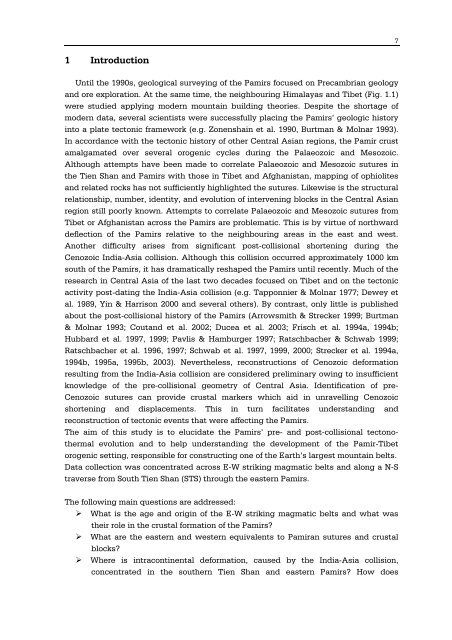tübinger geowissenschaftliche arbeiten (tga) - TOBIAS-lib ...
tübinger geowissenschaftliche arbeiten (tga) - TOBIAS-lib ...
tübinger geowissenschaftliche arbeiten (tga) - TOBIAS-lib ...
Create successful ePaper yourself
Turn your PDF publications into a flip-book with our unique Google optimized e-Paper software.
1 Introduction<br />
Until the 1990s, geological surveying of the Pamirs focused on Precambrian geology<br />
and ore exploration. At the same time, the neighbouring Himalayas and Tibet (Fig. 1.1)<br />
were studied applying modern mountain building theories. Despite the shortage of<br />
modern data, several scientists were successfully placing the Pamirs’ geologic history<br />
into a plate tectonic framework (e.g. Zonenshain et al. 1990, Burtman & Molnar 1993).<br />
In accordance with the tectonic history of other Central Asian regions, the Pamir crust<br />
amalgamated over several orogenic cycles during the Palaeozoic and Mesozoic.<br />
Although attempts have been made to correlate Palaeozoic and Mesozoic sutures in<br />
the Tien Shan and Pamirs with those in Tibet and Afghanistan, mapping of ophiolites<br />
and related rocks has not sufficiently highlighted the sutures. Likewise is the structural<br />
relationship, number, identity, and evolution of intervening blocks in the Central Asian<br />
region still poorly known. Attempts to correlate Palaeozoic and Mesozoic sutures from<br />
Tibet or Afghanistan across the Pamirs are problematic. This is by virtue of northward<br />
deflection of the Pamirs relative to the neighbouring areas in the east and west.<br />
Another difficulty arises from significant post-collisional shortening during the<br />
Cenozoic India-Asia collision. Although this collision occurred approximately 1000 km<br />
south of the Pamirs, it has dramatically reshaped the Pamirs until recently. Much of the<br />
research in Central Asia of the last two decades focused on Tibet and on the tectonic<br />
activity post-dating the India-Asia collision (e.g. Tapponnier & Molnar 1977; Dewey et<br />
al. 1989, Yin & Harrison 2000 and several others). By contrast, only little is published<br />
about the post-collisional history of the Pamirs (Arrowsmith & Strecker 1999; Burtman<br />
& Molnar 1993; Coutand et al. 2002; Ducea et al. 2003; Frisch et al. 1994a, 1994b;<br />
Hubbard et al. 1997, 1999; Pavlis & Hamburger 1997; Ratschbacher & Schwab 1999;<br />
Ratschbacher et al. 1996, 1997; Schwab et al. 1997, 1999, 2000; Strecker et al. 1994a,<br />
1994b, 1995a, 1995b, 2003). Nevertheless, reconstructions of Cenozoic deformation<br />
resulting from the India-Asia collision are considered preliminary owing to insufficient<br />
knowledge of the pre-collisional geometry of Central Asia. Identification of pre-<br />
Cenozoic sutures can provide crustal markers which aid in unravelling Cenozoic<br />
shortening and displacements. This in turn facilitates understanding and<br />
reconstruction of tectonic events that were affecting the Pamirs.<br />
The aim of this study is to elucidate the Pamirs’ pre- and post-collisional tectonothermal<br />
evolution and to help understanding the development of the Pamir-Tibet<br />
orogenic setting, responsible for constructing one of the Earth’s largest mountain belts.<br />
Data collection was concentrated across E-W striking magmatic belts and along a N-S<br />
traverse from South Tien Shan (STS) through the eastern Pamirs.<br />
The following main questions are addressed:<br />
� What is the age and origin of the E-W striking magmatic belts and what was<br />
their role in the crustal formation of the Pamirs?<br />
� What are the eastern and western equivalents to Pamiran sutures and crustal<br />
blocks?<br />
� Where is intracontinental deformation, caused by the India-Asia collision,<br />
concentrated in the southern Tien Shan and eastern Pamirs? How does<br />
7

















